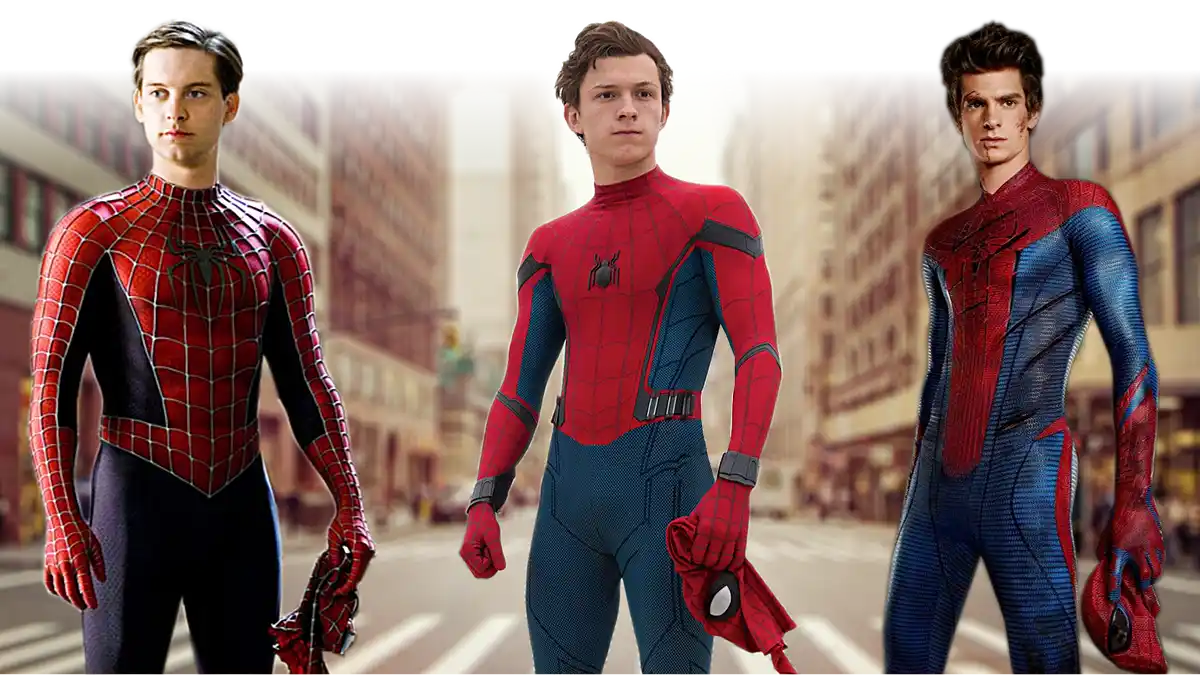Spider-Man has been a popular comic book superhero since he first appeared in Amazing Fantasy #15 in 1962. Created by Stan Lee and Steve Ditko, Spidey has been web swinging on the pages of comics and newspapers, in cartoons, television shows, movies, video games, amusement parks, popsicles, and even on Broadway. This post attempts to catalog Spidey’s first fifty years on the big screen, including behind the scene struggles to produce films, his imprisonment within Sony Pictures, and what the future holds for our friendly neighborhood Spider-Man.
The Pre-Raimi Years
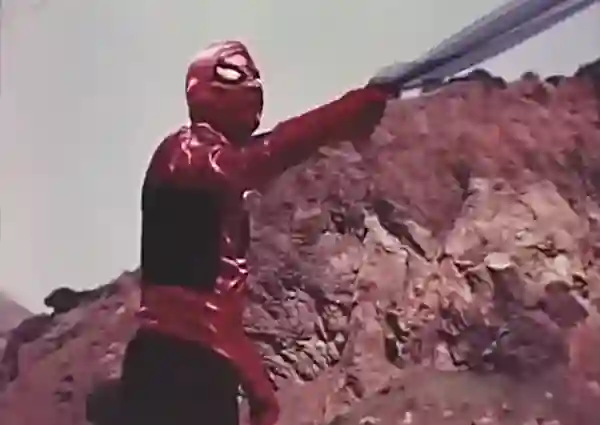
Donald F. Glut's Spider-Man fan film.
Spider-Man premiered on film in the 1969 fan film Spider-Man, featuring special visual effects, miniatures, explosions, and stunts performed by a Spider-Man blow-up doll. The climax (at about the ten minute mark) features Spidey swinging after the villainous Dr. Lightning (played by Doctor Doom in a t-shirt) as he attempts to make his escape in a red muscle car. The film was made by amateur filmmaker Donald F. Glut (who also starred as Spidey) and who had previously made several other superhero-related fan films. Glut would later go on to write for the classic 80’s Spider-Man cartoon series and a variety of other cartoons, including an episode of X-Men: The Animated Series. Glut’s Spider-Man fan film was actually screened at the University of Southern California, truly making it the first Spider-Man film shown in a cinema.

The first official live-action Spider-Man film was the 1977 CBS TV movie Spider-Man, staring Nicholas Hammond as Peter Parker/Spider-Man and featuring mind-controlled bad guys. The ’77 Spider-Man, while not a true cinematic release, launched a live-action TV series that ran for 13 episodes with impressive (for the time) wire work that gave Spidey his ability to wall crawl. The series also features cheesy dialogue, a disco soundtrack, and bellbottoms. Two theatrical releases were eventually produced for distribution only in Europe by editing together multiple episodes.

Also in the late 70’s, Toei Company, a Japanese production company, released their own version of Spider-Man on television and in theaters. While Spider-Man has all of his normal abilities — shooting webs, climbing on walls, Spider Sense, and the classic red-and-blue costume — his extraterrestrial origin and the enemies he faces are entirely unique to Japan. In the 40 episode series, Takuya Yamashiro uses a large wrist device to transform into Spider-Man to fight a monster-of-the-week type villain. Near the end of the fight the monster grows into a giant version of itself, at which point Spider-Man calls down his spaceship that transforms into a giant robot with a sword, and he defeats the monster in a huge explosion. This was a very different Spider-Man created for kids and designed to sell toys, with Spider-Man’s robots and cars created out of necessity as a way to finance the show. If all of this is beginning to sound mighty familiar to you, this is probably because Spider-Man‘s success in Japan heavily influenced the Toei-produced Super Sentai series, better known in the West as Mighty Morphin’ Power Rangers.
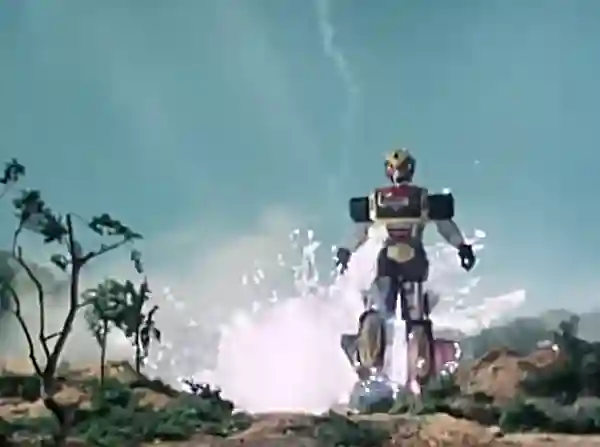
Toei's Spider-Man, piloting his giant robot, Leopardon.
When Toei began work on Spider-Man, they put the current Super Sentai series on hiatus for a year. When production resumed, the Battle Fever J team introduced giant mechas to the franchise, a staple of Super Sentai to this day. And later, Spider-Man’s transforming robot, Leopardon, would also heavily influence the creation of the Marvel comic book The Transformers (in which Spidey briefly battles Megatron). Stan Lee praised Japan’s Spider-Man TV series for the action and special effects, noting that Japan’s culture necessitated different approaches to the traditional Marvel character.Back in America in the mid-80’s, Stan Lee veto’ed the “Peter Parker transforms into a giant, hairy, eight-armed tarantula and is locked in a basement after refusing to join a mutant master-race” concept at Cannon films. Spider-Man languished in development hell as budgets were slashed repeatedly over the next decade. Due to the failures of Superman IV and Masters of the Universe, Cannon eventually bailed on the whole idea of a superhero movie and the film rights to Spider-Man found their way to 21st Century Film Corp. At one point James Cameron submitted a script draft with Arnold Schwarzenegger attached to play Doc Ock. (Let’s just pause for a moment and imagine the alternate reality where that film was made. Okay, let’s move on.) As part of a severance package from Cannon Films, co-owner Menahem Golan walked away with 21st Century Film Corp. and the film rights to Spider-Man (and Captain America). To get financing for the Spider-Man film, Golan sold the TV, home video, and theatrical rights to three different companies, but of course the film was never made. In 1995 a judge ruled that the film rights as originally sold to Cannon had now reverted back to Marvel, but a year later, with the entire comics industry hurting, Marvel filed for bankruptcy. With the bankruptcy came the ToyBiz merger, with co-owner Avi Arad becoming Marvel’s CEO. Marvel sold the film rights to their most popular characters for whatever amount of cash they could get in the late 90’s. Sony Pictures picked up the film rights to Spidey in 1999 for a mere $7 million, which is where Spider-Man remains jailed in perpetuity.
Tobey Suits Up
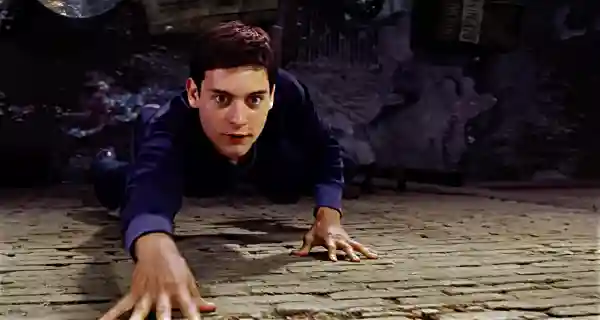
Tobey Maguire as Peter Parker in 2002's Spider-Man.
Staring Tobey Maguire and directed by Sam Raimi, 2002’s Spider-Man was a massive success and the first film to earn $100 million in an opening weekend. (I know, how quaint, right?) The original teaser trailer for the film shows a helicopter trapped in a giant spider web strung between the World Trade Center towers, and the original theatrical poster has the towers reflected in the eyes of Spider-Man’s mask. Both the trailer and poster were recalled after the 9/11 attacks. In the film, Spider-Man’s classic origin story is played out in full as Peter Parker is bitten by a radioactive spider, gains spider-like abilities, watches Uncle Ben die, kisses Mary-Jane Watson (Kirsten Dunst) while hanging upside down, battles the Green Goblin (Willem Dafoe), saves New York City, and – oh yeah – shoots webbing out of slits in his wrists. Now, spiders don’t shoot webbing out of their little spider legs, they actually pull webbing from their – well, it doesn’t matter, the film was a huge hit.
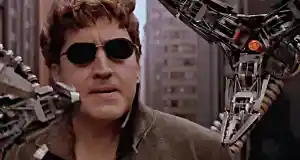
The 2004 sequel Spider-Man 2 featured Alfred Molina as Doctor Octopus and focused on Peter Parker’s desire to be “Spider-Man No More!” (a plot thread largely influenced by Amazing Spider-Man #50). The film was made so long ago that it was cheaper to use practical tentacles for many of the shots of Doc Ock instead of computer visual effects. This movie was another huge hit, remaining the top rated live-action Spider-Man film until 2021.
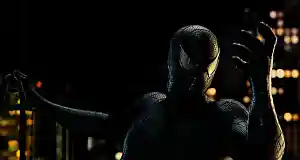
Then Spider-Man 3 somehow happened. In the film, Spidey takes on Sandman, the Goblin, and Venom, while also dancing and pointing at women on a crowded New York sidewalk. 2007 was a bad year for Spider-Man. Sam Raimi’s rein on theatrical Spider-Man films is finally put to a stop after this train wreck, and a planned Part 4 will never see the light of day. Spider-Man is officially rebooted just five years later.
The Andrew Garfield Reboot
The Amazing Spider-Man, directed by Marc Webb and staring Andrew Garfield, is another big success in the Spider-Man franchise despite re-treading the same origin story audiences saw just a decade earlier. Future Academy Award winner Emma Stone stars as Gwen Stacy, replacing MJ as Peter’s love interest, and the Lizard (Rhys Ifans) is the new solo villain. Amazing features the return of Peter’s self-designed, artificial web shooters and the first time Peter’s parents are seen on film before ominously disappearing. There were many plot threads left open by the end of the film and many characters in the shadows we never see, with the clear intention of building a Spider-Man Cinematic Universe to compete with the growing popularity of the Marvel Cinematic Universe.
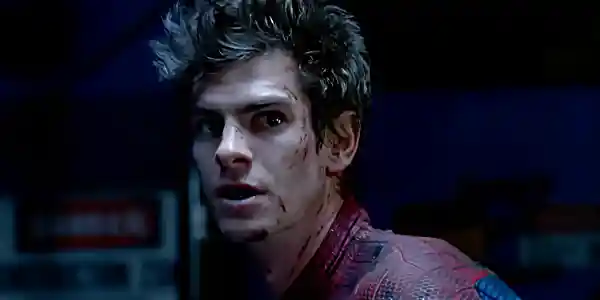
Andrew Garfield is The Amazing Spider-Man.
The Amazing Spider-Man 2 forced audiences to sit through 141 minutes of fake teen relationship drama no one wants to see in a superhero movie. Electro (Jamie Foxx) and the Green Goblin (Dane DeHaan) are Spidey’s foes this time around, while Black Cat and the Rhino make some blink-and-you-miss-them cameos. More backstory is revealed about the disappearance of Peter’s parents, but before all the mysteries are revealed the film is over and the bad reviews are out.
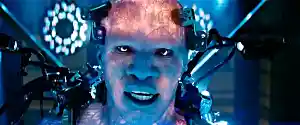
The Amazing Spider-Man 2 was supposed to be a major launchpad for Sony’s Spider-Man Cinematic Universe, with Venom, the Sinister Six, Black Cat, Spider-Man 2099, and two additional Garfield-staring Spider-Man films planned and in various early stages of production. However, after Amazing 2‘s poor box office performance and lackluster audience and critic reviews, Sony needed help. Amy Pascal, at the time a top executive at Sony Pictures, called Marvel’s Kevin Feige (who had produced previous Spider-Man films but had not been part of the Amazing Spider-Man 2‘s production) and asked for help on producing the next Spider-Man film. Feige pitched the idea of Tony Stark making Spidey’s suit, ultimately bringing Spider-Man into the sprawling MCU. Eventually, Pascal agreed, and Sony’s Spider-Man Cinematic Universe was shelved.
Spidey Swings into the MCU
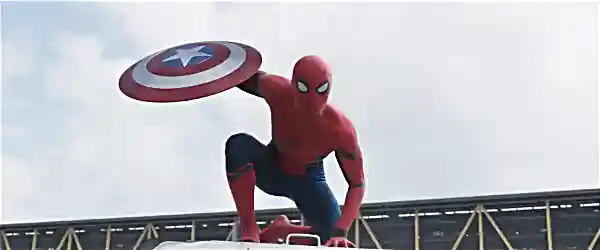
Tom Holland as Spider-Man in Captain America: Civil War.
In 2014, eighteen year old new-comer Tom Holland was cast as Spider-Man in Captain America: Civil War. Spidey finally joins Iron-Man, Captain America, Black Widow, Hawkeye, Ant-Man, Scarlet Witch, Winter Soldier, Falcon, War Machine, Vision, and (also making his MCU debut) Black Panther, in a German airport to fight against Cap as he attempts to track down the man who has brainwashed Bucky and caused the death of— you know what? The plot of Civil War is pretty convoluted. Spider-Man, however, makes a huge introduction to the MCU in this film. Peter Parker is young and funny, throwing classic Spidey quips during the battle, and the new Stark Suit is Very Cool (the re-sizing of the eyes allow for expression in the mask that hasn’t been seen on film before). Holland is introduced at almost exactly the half-way mark of Civil War (wearing a pizza t-shirt) and through a six minute chat with Tony Stark the audience skips the “bit-by-a-spider” origin story and we’re off to Germany. The chemistry between Tom Holland and Chris Evans, Sam Wilson, and Robert Downey Jr. is proof of the great casting that went into finding Holland for the role. Civil War is another huge success in both the MCU and Spider-Man franchises.

Spider-Man: Homecoming picks up immediately after where Civil War left off, with Peter Parker still euphoric over his fight against 50% of the Avengers. Homecoming, produced by both Pascal and Feige, introduces a few new characters to Peter’s world, including best friend Ned (Jacob Batalon) and future love interest Michelle, who goes by her initials MJ (Zendaya). Spidey battles Michael Keaton as the Vulture, and Robert Downey Jr. has a $10 million cameo as Iron-Man. Also showing up in cameo form is Donald Glover as Aaron Davis, aka The Prowler, aka Miles Morales’s Uncle, aka Childish Gambino, but so far, Miles has only shown up in animated form (more on that a little further down). Special nod towards Tony Revolori, who shines as Peter’s obnoxious nemesis Flash Thompson. Homecoming showcases Holland’s expert performance at being an awkward geek and a wise-cracking superhero. Missing from the Maguire/Garfield films were those moments in the comics when Spider-Man makes a trademark quip (or two, or twelve) during the fight with the villain. The audience also gets much more screen time with Spider-Man in-costume as the origin of his powers (and the explanation for where this bright red and blue suit magically appears from) have already been satisfactorily explained in Civil War. The MCU seems tired of retreading long, overplayed origin stories at this point and we’re now bee-lining into original stories with our heroes. No complaints here!

Spider-Man’s next MCU appearance will be the massive Avengers: Infinity War spectacle in 2018 and the following year’s Avengers: Endgame. In Infinity War, Spidey heads to space with Iron-Man and Doctor Strange where he meets up with the Guardians of the Galaxy to battle Thanos. Star Lord goes off-script and Thanos defeats the team in space before heading to Earth to complete his collection of Infinity Stones. With the snap of his fingers, Thanos breaks the heart of every person in the theater as they watch Peter Parker dissolve into dust.

Five years of movie time (and one very long real year) pass before Endgame picks up again as the remaining Avengers devise a plan to travel into the past and borrow the Infinity Stones from previous MCU films. The Avengers snap-back everyone dusted by Thanos, who’s past self shows up to try the whole snapping plan again. Spider-Man joins the Avengers and almost everyone else from every other MCU film as they fight the big purple guy once more and his massive army of Chitauri. Tony Stark sacrifices himself to save the world, proclaiming once again that he is Iron-Man. The Earth’s Mightiest Heroes hold a funeral for their fallen friend.
Spider-Man: Far from Home picks up just days after the events Endgame, coining the disappearance and reappearance of those affected by Thanos’s snap as “the blip.” Conveniently, all of Peter’s classmates are blipped, so they all return for the sequel. The class takes a little field trip to Europe, where Spider-Man meets a version of Nick Fury and Maria Hill, and encounters new BFF Quentin Beck/new arch-nemesis Mysterio. Spider-Man is given special Tony Stark designed spectacles, called E.D.I.T.H., that can summon killer drones and hack smartphones. Peter also self-designs a new black and red suit in a homage to the original Iron-Man suit design montage, complete with “Back in Black” soundtrack. (Happy gets the reference.) By the end of the film Peter’s secret identity is now known by Happy Hogan, Aunt May, Ned, MJ, Mysterio, everyone working at S.H.I.E.L.D, everyone fired from Stark Industries, and, oh right, the entire planet, as J. Jonah Jameson (J. K. Simmons, reprising his role from the Tobey Maguire films) shares Beck’s final parting words with all of New York: “Spider-Man’s name is Peter Parker!”

Shortly after Far from Home crossed the billion dollar box office mark, a new record for a Spider-Man film, Marvel and Sony announced they had been unable to reach a new agreement to continue co-producing future Spider-Man films. Spidey would exit the MCU, and Sony would return to independently producing future Spider-Man films, keeping Tom Holland as Spidey. A few weeks later, Marvel and Sony announced a new agreement had finally been reached, with Marvel co-producing the next Spider-Man film. Financially, Marvel’s parent company, The Walt Disney Company, will be footing 25% of the cost of production and taking 25% of the box office haul – and as Far from Home has proven, 25% of a Spider-Man box office is still a massive payday, even for Disney.
This was an important agreement for Disney to make. With the Marvel lands opening at various Disney Parks over the next couple of years, and the Spider-Man ride specifically swinging into Disney California Adventure in 2021, getting Spidey back into the MCU was a must. The story as Disney CEO Bob Iger tells it is Tom Holland called him on the phone about the deal with Sony and encouraged him to fix it. Iger called Sony and he said, “we have to get this done, for Tom and for the fans.” And to both of these massive corporation’s credit, they did.
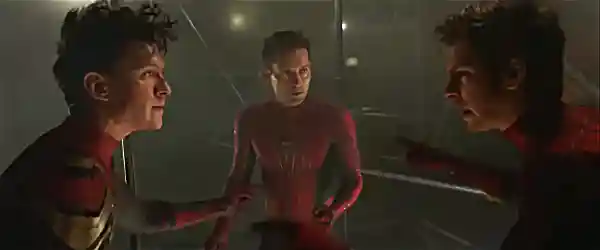
Tom, Tobey, and Andrew as Spider-Man, Spider-Man, and Spider-Man in Spider-Man: No Way Home.
Spider-Man: No Way Home (delayed due to the COVID-19 pandemic) released on December 17th, 2021, co-produced by Marvel and Sony, with Tom Holland returning for the sixth time as Spidey. Joining him are Zendaya as MJ, Benedict Cumberbatch as Doctor Strange, Jon Favreau as Happy, Jacob Batalon as Ned, Marisa Tomei as Aunt May, Benedict Wong as Wong, Willem Dafoe as the Green Goblin, Alfred Molina as Doctor Octopus, Jamie Foxx as Electro, Rhys Ifans as the Lizard, Thomas Haden Church as Sandman, and with Tobey Maguire and Andrew Garfield returning as their multiverse Spider-Man counterparts from the previous Sony francises. (In the script, they’re referred to as Raimi-Verse Peter and Webb-Verse Peter, after the names of the previous film’s directors.) In the film, Peter Parker attempts to undo his public outing as Spider-Man with the help of “Mr. Strange” but the spell goes awry, tearing open the walls between the multiverse and attracting both friend and foe from universes beyond Peter’s own. The film spends a great deal of time tying up loose threads from the previous Spider-Man franchises and allowing previous heroes and villains to make amends with their past. Working together, the three Spider-Men are able to cure the five villains, but repairing the multiverse causes the entire world to forget Peter Parker, including Ned and MJ. This is also the first time in the MCU a character says the line, “with great power, comes great responsibility”. Even during an exceptionally deadly rise in the ongoing COVID-19 pandemic, No Way Home became the sixth highest grossing film of all time, earning over $1.7 billion worldwide. It was the highest grossing film of 2021, the highest grossing Spider-Man film, and Sony’s highest grossing film of all time — quite the return on a seven million dollar purchase in 1999. Critics and audiences praised the film’s actors, direction, and visual effects.
And Miles to Go
Shortly before No Way Home premiered, Holland stated that playing Spider-Man as a thirty year old meant he had “done something wrong“ during his career and that No Way Home was the final film in his Spidey contract, highly suggesting he was exiting the role sooner rather than later. However, a few weeks later Sony producer Amy Pascal stated that work had begun on a new trilogy of Spider-Man films with Holland, with Marvel producer Kevin Feige promising the partnership between Disney and Sony would continue through this new trilogy. The details on Holland’s contract are vague, but it’s safe to assume there’s a future Avenger’s clause somewhere in it.
Speaking of future MCU films, Jon Watts — director of the three most recent MCU Spidey films — will be directing the MCU’s Fantastic Four. No cast or date has been announced, but 2023 sounds like a reasonable timetable for release. I mention this only because the inclusion of Tom Holland as Spider-Man seems like an obvious pairing of the heroes. Putting Spidey in the Fantastic Four gives Marvel’s First Family a huge introduction and, maybe most importantly, sets it apart from previous FF films that have not been super successful (or good). Telling a story with the Fantastic Four and Spider-Man is something never before seen on the big screen, and the possibilities of putting a paper bag over Tom Holland’s head are endless
While we wait for news on the next Spider-Man film, Sony has been working on some other standalone Spider-Man-related projects, some of which have already been released, and some which are releasing soon:
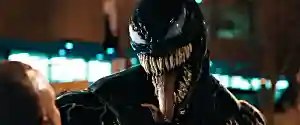
Sony released Venom in 2018, a reboot of the character from the Tobey Maguire Spider-Man days. Venom stars Tom Hardy as Eddie Brock, a reporter down on his luck who breaks into a medical research center and comes into contact with the symbiote, forming a buddy-cop type relationship. In the comics, much of the character of Venom is based on Spider-Man, but this film version of Venom is not set in any Spider-Man universe, and his film origin shares nothing with the wall crawler. In the comics, the design of Venom is based heavily on Spider-Man. Venom’s eyes, the way he attacks with those tentacle-like globs, his ability to wall crawl, his ability to react to danger – basically everything that makes the character who he is, he learned from Peter Parker as the symbiote. Including, crucially, Peter’s sense of power and responsibility, which changes Venom from the monster that he was into the comic book hero he’s become in recent years. Venom as a standalone character without the Spider-Man origin feels hollow and turns the Venom film into a generic monster movie. Despite Venom receiving mostly negative reviews from critics, it made a lot of money at the box office, so Sony made a sequel.
Venom: Let There Be Carnage introduces the Carnage symbiote into Sony’s Venom-verse. Serial killer Cletus Kasady (Woody Harrelson) is on death row when he bites Eddie Brock, unknowingly infecting himself with the symbiote. In the comics, Spidey and Venom often team up to defeat Carnage, but the film version of Venom manages to eek out a win. By the end of the film, Eddie Brock is a wanted fugitive and leaves the country. While staying in a dingy motel, he’s transported to the Marvel Cinematic Universe, where he sees the news of Peter Parker being outed as Spider-Man. Hardy makes an uncredited cameo during an end credit scene of No Way Home in which Eddie Brock is sent back to his own dimension, but a tiny droplet of the Venom symbiote is left behind in the MCU.
Tom Holland filmed a Spider-Man cameo for the first Venom film but Marvel asked Sony to remove it. With the new agreement between the studios, Sony will be allowed to use Holland’s Spider-Man in their non-MCU films, including the brief cameo at the end of Let There Be Carnage and possibly in the upcoming Morbius film starring Jared Leto. This is Sony’s second attempt at launching a cinematic universe using Marvel’s Spider-Man characters, but while the films are not considered canon in the MCU, Sony considers the MCU events canon for their films. Confusing? Think of it like this: Sony’s films are fan fiction for the MCU.

Miles Morales does it his way in Spider-Man: Into the Spider-Verse.
Meanwhile, Sony won an Academy Award for Best Animated Feature with 2018’s Spider-Man: Into the Spider-Verse, topping Disney’s Ralph Breaks the Internet and Disney Pixar’s Incredibles 2. This was my favorite film of 2018 (a year with a lot of great movies, including Infinity War) and its Oscar win was well deserved. Into the Spider-Verse finally brings Miles Morales (Shameik Moore) to the Big Screen, telling a Spider-Man story with real heart, humor, and stunning animation. Swinging along with Miles is Peter B. Parker/Spider-Man (Jake Johnson), but a kind of washed up, out of shape, down on his luck Spider-Man who recently suffered a breakup with MJ. Gwen Stacy, aka Spider-Gwen (Hailee Steinfeld), Spider-Man Noir (Nicolas Cage), the anime-inspired Peni Parker (Kimiko Glenn) and her SP//dr mech, and Peter Porker/Spider-Ham (John Mulaney) also help Miles as he fights the Kingpin (Liev Schreiber) and Doctor Olivia “Liv” Octavius (Kathryn Hahn), saving the world from a collapse/explosion of the (animated) multiverse. Multiple Spider-Verse sequels are already in production, including a direct sequel Spider-Man: Across the Spider-Verse releasing in two parts — Part One on October 7, 2022 and part Two in 2023 — with Miles and Gwen being joined by Jessica Drew/Spider-Woman (Issa Rae), Miguel O’Hara/Spider-Man 2099 (Oscar Isaac), and Takuya Yamashiro, the Spider-Man from Toei’s Japanese Spider-Man series. I mean, how great is this movie going to be? Additionally, a Spider-Women spin-off with Gwen, Jessica Drew, and Cindy Moon (Silk) is also in development. I highly recommend watching Into the Spider-Verse on the biggest, highest-definition screen you can find with HDR enabled — it’s an absolutely beautiful film.
In 2021, the Marvel Cinematic Universe entered Stage 4 with new heroes, new movies, and new streaming series on Disney+ (Spider-Man appears in the Disney+ series What If... as Zombie Hunter Spider-Man). Marvel and Sony have a unique opportunity to work together and share these fan-favorite characters to tell stories of power and responsibility that have never before been told on screen. As long as Marvel and Sony can continue their Spider-Partnership, and as long as audiences continue going to the movies in record numbers, the cinematic future of our friendly neighborhood Spider-Man has never been more amazing.

